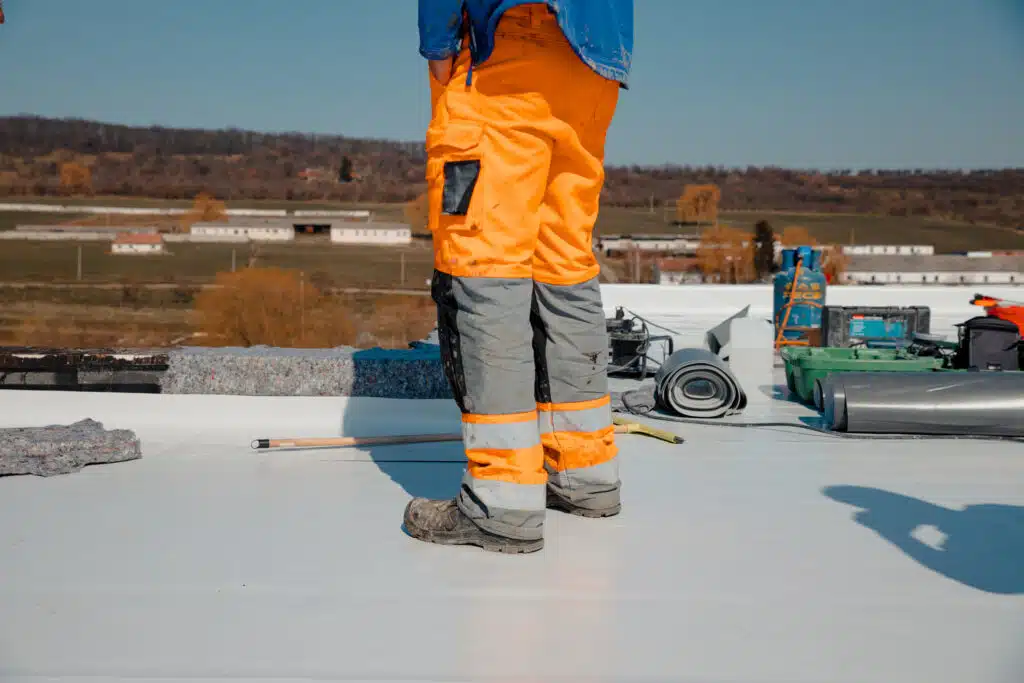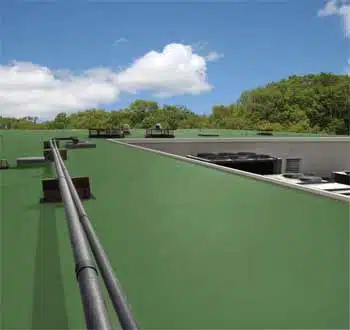Energy efficiency is a crucial aspect of modern construction. It’s about reducing environmental impact and achieving significant cost savings.
Flat roofs, often seen in commercial and industrial buildings, play a key role. They can significantly contribute to a building’s overall energy performance.
However, achieving energy efficiency in flat roofs is not straightforward. It requires a comprehensive understanding of various factors.
These include the proper insulation, the use of appropriate roofing materials, and the implementation of adequate installation and maintenance practices.
This guide aims to provide homeowners, construction project managers, and roofing contractors with the necessary knowledge. It will delve into the intricacies of maximizing energy efficiency in flat roofs.
So, whether you’re planning a new build, considering a roof replacement, or just want to improve your existing roof’s performance, this guide is for you. Let’s explore how to make the most of your flat roof for energy efficiency.
Understanding Flat Roof Energy Efficiency
Flat roofs are inherently different in design from sloped roofs, yet they can contribute significantly to energy savings. Understanding the unique dynamics of flat roofs is essential to maximizing energy efficiency.
Energy efficiency for flat roofs involves minimizing heat gain and loss. This can be more challenging due to their horizontal nature, which exposes them to more direct sunlight.
Moreover, flat roofs often host HVAC systems, creating the potential for increased thermal loads. Therefore, an efficient flat roof design must balance insulation, cooling, and material reflectivity.
The impact of a flat roof’s energy efficiency extends throughout a building. Poor design can result in higher energy use for heating and cooling.
To combat this, key strategies include selecting the right materials and incorporating modern technologies. These elements work together to enhance a building’s overall efficiency.
Finally, understanding local climate conditions is vital. These conditions directly influence the choice of materials and design strategies for optimal performance.
The Role of Insulation in Flat Roofs
Insulation is a barrier to heat transfer, which is crucial for flat roofs. It plays a pivotal role in maintaining thermal comfort within a building.
Different types of insulation suit different needs, with polyisocyanurate and expanded polystyrene being common choices. Each offers varying levels of thermal resistance, measured by the R-value.
A higher R-value means better insulation, crucial in extreme climates. It helps keep heat out in summer and holds warmth in winter, significantly affecting energy use.
Proper insulation installation prevents thermal bridging. This issue allows energy to escape through gaps or poorly insulated areas, reducing efficiency.
Quality insulation installation ensures that your flat roof performs optimally, contributing to overall energy efficiency. It also underscores the importance of hiring experienced contractors.
Reflective Materials and Roof Coatings
Reflective roofing materials and coatings are excellent for energy efficiency. They minimize heat absorption by reflecting sunlight, which reduces cooling needs.
Using light-colored membranes or coatings is beneficial, especially in sunny climates. They reflect more light, preventing heat build-up in the building below.
The emissivity of a roofing material also matters. High-emissivity materials release absorbed heat quickly, further enhancing energy performance.
Roof coatings, such as elastomeric coatings, add a layer of UV protection. They extend the life of the roof while contributing to energy efficiency.
Integrating reflective materials with proper roof design can drastically improve a building’s energy efficiency. This sustainable choice conserves energy and reduces costs in the long run.
Selecting the Right Flat Roof Materials
Choosing appropriate materials for flat roofs is crucial for maximizing energy efficiency. The right materials can significantly influence thermal performance and overall sustainability.
Different materials offer varying benefits. For instance, some materials better suit environments prone to heavy rain, while others excel under intense sunlight.
Considering climate and building specifics is key. Material selection should also align with energy performance goals and lifespan expectations.
Ultimately, the material choice impacts both the immediate and long-term energy efficiency of the building. It requires careful evaluation of all contributing factors.
Single-Ply Roofing Systems
Single-ply roofing systems are popular for their versatility and efficiency. They consist of prefabricated membranes, which make installation quicker and more efficient.
These systems offer excellent durability and flexibility, which are critical for flat roofs. They are often lightweight, reducing structural load and enhancing energy efficiency.
Prefabricated options minimize waste on-site and contribute to a cleaner installation process. This aspect also reduces project completion times, saving costs.
Moreover, many single-ply systems have reflective properties. Their ability to reflect sunlight helps maintain indoor temperatures, supporting energy savings year-round.
Installation and Maintenance Best Practices
Implementing best practices in installation and maintenance is vital for flat roof energy efficiency. Proper techniques ensure longevity and minimize energy loss. Precision during installation prevents future issues and maximizes insulation effectiveness.
Regular maintenance supports the roof’s long-term performance. It helps identify early signs of wear or damage that could affect energy efficiency. Addressing these issues quickly saves energy and reduces costs over time.
Routine checks and energy audits are pivotal. They assess the roof’s current condition, allowing timely corrections. This proactive approach enhances overall energy efficiency and system reliability.
Collaborating with experienced professionals ensures high-quality installation and maintenance practices. These experts possess the necessary skills to optimize the roof’s energy performance effectively.
Importance of Proper Installation
Proper installation lays the foundation for energy efficiency. It ensures all components function as intended. Mistakes during installation can lead to energy loss.
Accurate alignment and secure fastening prevent thermal bridging. This care contributes to the roofing system’s overall efficiency.
Regular Maintenance and Energy Audits
Regular maintenance keeps the roof in optimal condition. It extends the roof’s life and sustains energy efficiency.
Conducting energy audits uncovers potential efficiency improvements. These evaluations guide necessary adjustments to maintain peak performance.
Leveraging Technology for Efficiency
Modern technology significantly enhances flat roof energy efficiency. Innovative tools help pinpoint areas for improvement. This leads to precise, effective solutions and optimized energy use.
Adopting these technologies supports better decision-making. They enable targeted actions to increase performance and reduce energy costs. Consequently, roofs perform well under varying conditions.
TPO Roofs: Enhancing Energy Efficiency in Flat Roofs
Thermoplastic Polyolefin (TPO) roofing systems represent a significant advancement in commercial roofing technology, particularly when enhancing energy efficiency in flat roofs. This innovative roofing material has gained substantial popularity among building owners and facility managers looking to reduce their energy costs while contributing to environmental sustainability. Below, we delve into how TPO roofs contribute to energy efficiency in flat-roofed commercial buildings.
Reflective Properties
One of the most notable features of TPO roofing is its high reflectivity. The surface of a TPO roof is designed to reflect sunlight and UV rays, rather than absorb them like traditional roofing materials. This reflective capability means that less heat is transferred into the building, keeping indoor temperatures more stable during hot weather. As a result, there is a significant reduction in the demand for air conditioning, leading to lower energy consumption and cost savings on cooling bills.
Superior Insulation
TPO roofs not only reflect solar energy but also provide excellent insulation properties. This helps maintain consistent indoor temperatures regardless of outdoor weather conditions. By acting as a barrier to heat transfer, TPO roofing systems ensure that the energy used for heating or cooling the building is utilized efficiently, further enhancing the building’s overall energy performance.
Durability and Longevity
TPO roofs’ energy efficiency is also attributed to their durability and longevity. Made to withstand extreme weather conditions, chemical exposure, and UV rays, TPO roofs maintain their integrity and performance over time. This resilience means that the roofs require fewer repairs and replacements, which saves on costs and reduces the energy and resources associated with roofing materials production and installation.
Lightweight and Easy Installation
TPO roofing materials are lightweight and can be installed with less energy-intensive methods than traditional roofing systems. This aspect not only makes the installation process more efficient but also reduces the overall carbon footprint associated with the construction phase of the roofing system. Furthermore, the ease of installation minimizes disruptions to the building’s operations, allowing for business activities to continue without significant energy loss.
Seal the Deal on Sustainability: Why TPO Roofing Houston is Your Key to Energy-Efficient Flat Roofs
As we explore the myriad ways to maximize energy efficiency for flat roofs, it becomes abundantly clear that the material chosen for your roofing project plays a pivotal role. Among the available options, TPO roofing stands out as a beacon of efficiency, sustainability, and cost-effectiveness. However, material alone does not guarantee success; the expertise and execution behind its installation are crucial. This is where TPO Roofing Houston emerges as a distinguished partner in your journey toward energy efficiency.
TPO Roofing Houston symbolizes excellence in flat roof installations. Specializing in TPO roofing systems, our team is not only knowledgeable about the nuances of roofing but also deeply committed to energy conservation and sustainable building practices. By selecting TPO Roofing Houston, you partner with a company that prioritizes your energy goals, ensuring that every step from design to installation is executed with precision and care.
Our extensive experience with TPO roofing systems translates into direct benefits for your building. From the initial assessment, we prioritize understanding your specific needs, considering the local climate, your building’s architecture, and your energy usage patterns. This thorough approach allows us to provide a TPO roofing solution that is not only customized to your requirements but also optimized for maximum energy efficiency.
Moreover, TPO Roofing Houston’s commitment to quality doesn’t end with installation. We believe in creating lasting relationships with our clients, offering maintenance and repair services to ensure your roofing system continues to operate at peak efficiency for years to come. This dedication to service ensures that your investment in a TPO roof yields sustainable savings, reducing your energy bills and minimizing your environmental footprint.
In conclusion, if you want to maximize energy efficiency in your flat roof, TPO Roofing Houston is the name to trust. Our focus on high-quality materials, expert installation, and ongoing support makes us the top choice for businesses and property owners aiming for sustainability. Please don’t settle for less when it comes to the performance and efficiency of your flat roof. Contact TPO Roofing Houston today and take a meaningful step toward a greener, more sustainable future.





